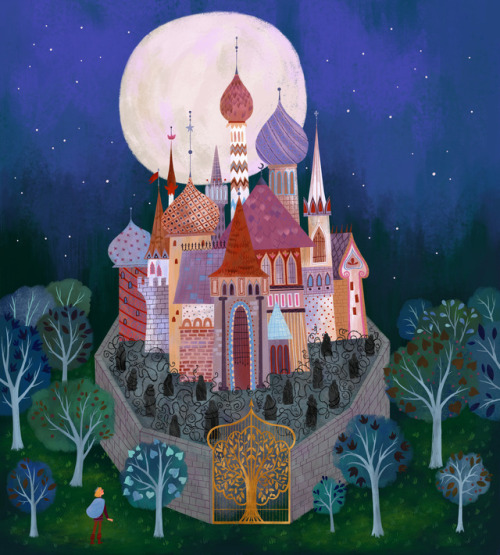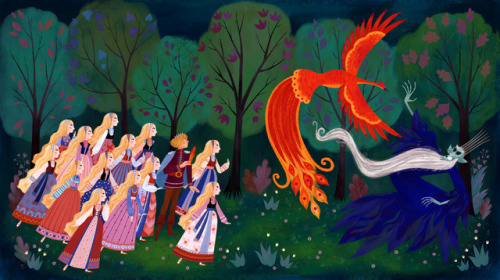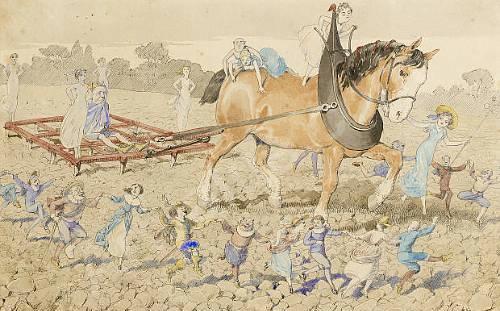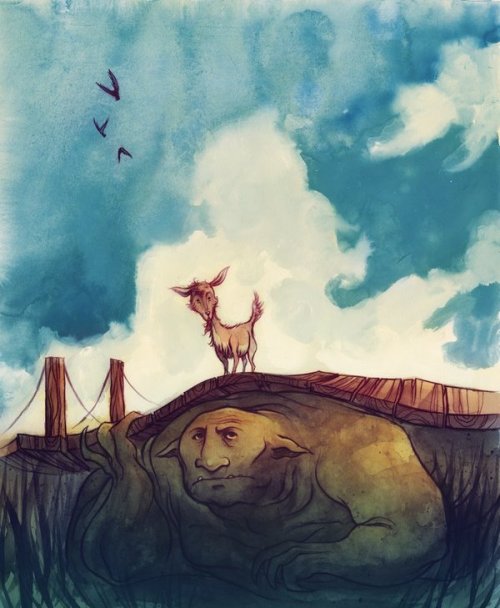#folktales
Hi there!! I’ve been working on a retelling of the tale “East of the Sun, West of the Moon”. Here are the first characters I’ve designed for it, Ellinor (the protagonist) and the troll princess.
In the original tale, the troll princess was meant to be an ugly princess with a big nose, as a way to make worse the fate of the prince, but I think that it doesn’t matter how pretty she is, the prince is not going to accept someone by force.
And well, my troll princess is not very smart, she’s kind of clumsy and gets easily distracted, specially if it is about jewels and treasures (I added this after discovering that some trolls love gold and some details of the story). She is kind, but always tries to please her mother.
Ellinor is a bit fragile, kindhearted, clever and gets easily scared, but she is very brave, and faces her fears, usually tries to pretend she’s not scared. She’ll travel to save the prince from the curse. I still have a long way to go with her, but I’ll get there!!
These might not be the final designs, but I’m having a lot of fun in this journey! n.n
Post link
Old folk and fairy tales are wild. Sometimes they’re filled with hidden gems like how to consort with spirits, make bones talk, and unlock portals to other realms…and other times they’re talking shit on the farmer’s wife down the lane from three generations ago or attempting to explain why corn and beans grow in the shape that they do.

‘DISTEMPERED CRAVES,’ 2019-20
intimate wildseries
mixed-media collage on card stock
A John O’Brien illustration for The Stone Cheese from Favorite Tales of Monsters and Trolls retold by George Jonsen 1977 #folktales #fairytale #monstersandtrolls #johnobrienart #oldchildrensbooks
https://www.instagram.com/p/CG8hJvYHI21/?igshid=1x5v40rk15af2
Post link
Mega Book bundle giveaway for India!!
I am hosting a 14 book giveaway for India on Twitter, but you can also apply here:
1. Donate $10+ to an Indian COVID relief fund (listed below)
2. Reply/DM with proof of donation.
3. Reblog this post
4. Winner will be picked at random in May 14th.
Books & Charities listed below. Open to wherever Amazon ships.
Donations:
Any from this list:
The Books

1. These Hills Called Home
2. The Last Jews of Kerala
3. Born a Muslim
4. Midnight’s Furies
5. Wanderers, Kings, Merchants: The Story of India through Its Languages
6. The Bloomsbury Anthology of Great Indian Poems
7. Caste: The Origins of Our Discontents
8. Annihilation of Caste: The Annotated Critical Edition
9. Royals and Rebels: The Rise and Fall of the Sikh Empire
10. The Language of History: Sanskrit Narratives of Indo-Muslim Rule
11. Folktales from India
12. Unbreaking India: Decisions on Article 370 and the CAA
13. Inglorious Empire: what the British did to India
14. India After Gandhi Revised and Updated Edition: The History of the World’s Largest Democracy
At a time when the most despicable persons can be held to the highest standards, to show you the cover for this book seems relevant. Education and culture are the key, more than ever…
Post link
Often folktales and fairy stories can be quite brutal and serve as warnings not to mess with the fae. This story, set in Humshaugh, near Hexham in Northumberland, England, is very simple and rather charming. It’s the story of a ploughman who, one day in summer, heard the sound of the fairies churning their fairy butter. He knew not to pry, so he didn’t stop to listen for too long or try to see them, so he continued with his work. However, as he returned to the spot with his plough he heard a tiny voice saying, “Alack a-day, what shall I do? I’ve broken my churn staff”. He called back, “Leave it out for me to fix!” then walked away, knowing they wouldn’t come out with it whilst he was standing there. When he came back, there waiting for him was the broken churn which he immediately set about fixing. He left it, and once again returned to his ploughing, and when he returned for the final time he found the churn was gone and, in its place, a pile of fairy bread and fairy butter was left in thanks.
[Source: Fairy folk celebrating around a plough by Charles Altamont Doyle,Folk Tales of the North Country by F. Grice]
Post link
These two fairy tales are somewhat unusual as they are set not in the natural environment as so often folklore and fairy tales are, but in coal mines. The first is set in Shilbottle Colliery in Northumberland, England, near Alnwick and is the story of a mine spirit: the Bluecap. The second is from Callington Pit (also Northumberland) and tells the story of a boggart - Cutty Soams.
In the first, the Bluecap worked alongside the miners as a putter - someone who pushed (or dragged) the coal tubs. He worked hard, and kept the miners safe, manifesting himself in a blue flame. The miners paid him: if they overpaid him he would leave the surplus behind, but if they underpaid him he would become indignant, leave his wage, and potentially put the miners in danger.
Cutty Soams, on the other hand, delighted in putting the miners in danger (he was thought, perhaps, to be the ghost of a miner killed years earlier). As the Colliery Guardian wrote in 1863,
One [Cutty Soams] was a spiteful elf; who indicated his presence only by the mischief he perpetrated. He rejoiced in the name of “Cutty Soams,” and appears to have employed himself only in the stupid device of severing the rope-traces or soams, by which an assistant-putter – honoured by the title of “the fool ”– is yoked to the tub. The strands of hemp which were left all sound in the board at “kenner-time,” were found next morning severed in twain. “Cutty Soams” has been at work, could the fool and his driver say, dolefully knotting the cord.“
[Sources:Thomas Hair,The Faery Folklorist]
Post link


Barbarossa’s awakening by Hermann Wislicenus
“Legend says he is not dead, but asleep with his knights in a cave in the Kyffhäuser mountain in Thuringia, and that when the ravens cease to fly around the mountain he will awake and restore Germany to its ancient greatness. According to the story, his red beard has grown through the table at which he sits. His eyes are half closed in sleep, but now and then he raises his hand and sends a boy out to see if the ravens have stopped flying.”
The climactic scene of Japanese folktale The Grateful Crane, as interpreted by @stuartayre.
Post link
Baba Yaga, illustrated at the top by Russian artist Ivan Yakovlevich Bilibin (1876-1942) in our special collections copy of Василиса Прекрасная - Vasilisa Prekrasnai͡apublished in St. Petersburg in 1902, is one scary supernatural being. But at times, she’s also known to be helpful. Baba Yaga, who lives in a house described as having chicken legs (seen behind Vasilisa the Beautiful in the bottom image), is one of the most prevalent characters in eastern European folklore, going back at least until 1755…
Post link
Hi, just to let you know, I run a blog about Chinese myths here.
Go check it out, everyone :)
almost done! #babayaga #illustration #drawing #art #painting #acrylicpainting #watercolor #folktales
Post link



























